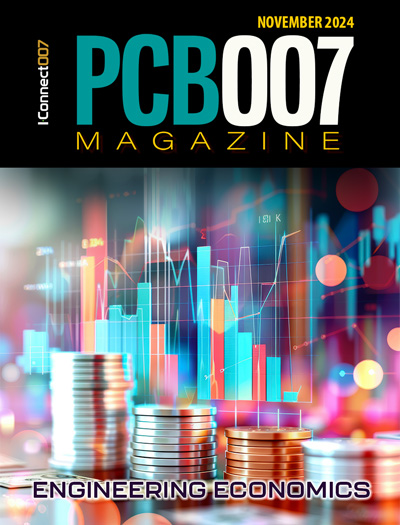-

- News
- Books
Featured Books
- pcb007 Magazine
Latest Issues
Current Issue
Inner Layer Precision & Yields
In this issue, we examine the critical nature of building precisions into your inner layers and assessing their pass/fail status as early as possible. Whether it’s using automation to cut down on handling issues, identifying defects earlier, or replacing an old line...

Engineering Economics
The real cost to manufacture a PCB encompasses everything that goes into making the product: the materials and other value-added supplies, machine and personnel costs, and most importantly, your quality. A hard look at real costs seems wholly appropriate.

Alternate Metallization Processes
Traditional electroless copper and electroless copper immersion gold have been primary PCB plating methods for decades. But alternative plating metals and processes have been introduced over the past few years as miniaturization and advanced packaging continue to develop.
- Articles
- Columns
Search Console
- Links
- Media kit
||| MENU - pcb007 Magazine
AI Demand Drives Rapid Growth in QLC Enterprise SSD Shipments for 2024
April 23, 2024 | TrendForceEstimated reading time: 2 minutes
North American customers are increasing their orders for storage products as energy efficiency becomes a key priority for AI inference servers. This, in turn, is driving up demand for QLC enterprise SSDs. Currently, only Solidigm and Samsung have certified QLC products, with Solidigm actively promoting its QLC products and standing to benefit the most from this surge in demand. TrendForce predicts shipments of QLC enterprise SSD bits to reach 30 exabytes in 2024—increasing fourfold in volume from 2023.
TrendForce identifies two main reasons for the increasing use of QLC SSDs in AI applications: the products' fast read speeds and TCO advantages. AI inference servers primarily perform read operations, which occur less frequently than the data writing required by AI training servers. In comparison to HDDs, QLC enterprise SSDs offer superior read speeds and have capacities that have expanded up to 64 TB.
Additionally, while mainstream HDDs used in general-purpose servers typically offer capacities of 20 to 24 TB, a single 64 TB QLC enterprise SSD not only consumes less power but also requires less space for storage capacity, significantly reducing TCO. As AI training becomes a high-energy-consuming application, energy efficiency is increasingly prioritized in storage products, making high-capacity QLC enterprise SSDs a sought-after solution for major AI clients.
Few QLC SSD suppliers remain as enterprise SSD contract prices expected to rise through Q3
TrendForce reports that in 4Q23, Samsung held over 40% of the market share in the enterprise SSD sector, while Solidigm, a long-time player in QLC enterprise SSDs, held a combined market share (SK Group) of 32%. Other suppliers, with market shares below 10%, see limited growth potential. Due to rising QLC orders, Solidigm plans to expand its production of 144-layer devices in 2H24. Samsung, which focuses on 176-layer devices and faces no significant competitors, is benefiting from the tight supply of high-capacity QLC products. This is expected to drive enterprise SSD contract prices up through the third quarter, with an estimated quarterly increase of 5% to 10%.
Consumer demand slumps with NAND Flash wafer prices showing signs of weakness
Observations of other end-user demand indicate that NAND Flash inventories for PC and smartphone customers continue to rise. ASP for products like client SSDs, eMMC, and UFS have rebounded more than 60% from their lows in the short term. However, with demand lagging, further price increases are expected to slow. Module makers are reducing inventory by selling NAND Flash wafers on the spot market at below-contract prices, further pressuring prices. TrendForce believes that as NAND Flash suppliers plan to increase production capacity utilization in 2H24, it will be challenging to raise quarterly contract prices for consumer-grade products, leading to weaker performance in NAND Flash quarterly contract prices compared to enterprise SSDs.
Suggested Items
Samsung Begins Industry's First Mass Production of QLC 9th-Gen V-NAND for AI Era
09/13/2024 | BUSINESS WIRESamsung Electronics Co., Ltd., the world leader in advanced memory technology, announced it has begun mass production of its one-terabit (Tb) quad-level cell (QLC) 9th-generation vertical NAND (V-NAND).
Memory Industry Revenue Expected to Reach Record High in 2025 Due to Increasing Average Prices and the Rise of HBM and QLC
07/22/2024 | TrendForceTrendForce’s latest report on the memory industry reveals that DRAM and NAND Flash revenues are expected to see significant increases of 75% and 77%, respectively, in 2024, driven by increased bit demand, an improved supply-demand structure, and the rise of high-value products like HBM.
Growing Demand for High-Capacity Storage Propels Enterprise SSD Revenue Up by Over 60% in 1Q24
05/31/2024 | TrendForceTrendForce reports that a reduction in supplier production has led to unmet demand for high-capacity orders since 4Q23. Combined with procurement strategies aimed at building low-cost inventory, this has driven orders and significantly boosted enterprise SSD revenue, which reached US$3.758 billion in 1Q24—a staggering 62.9% QoQ increase.


